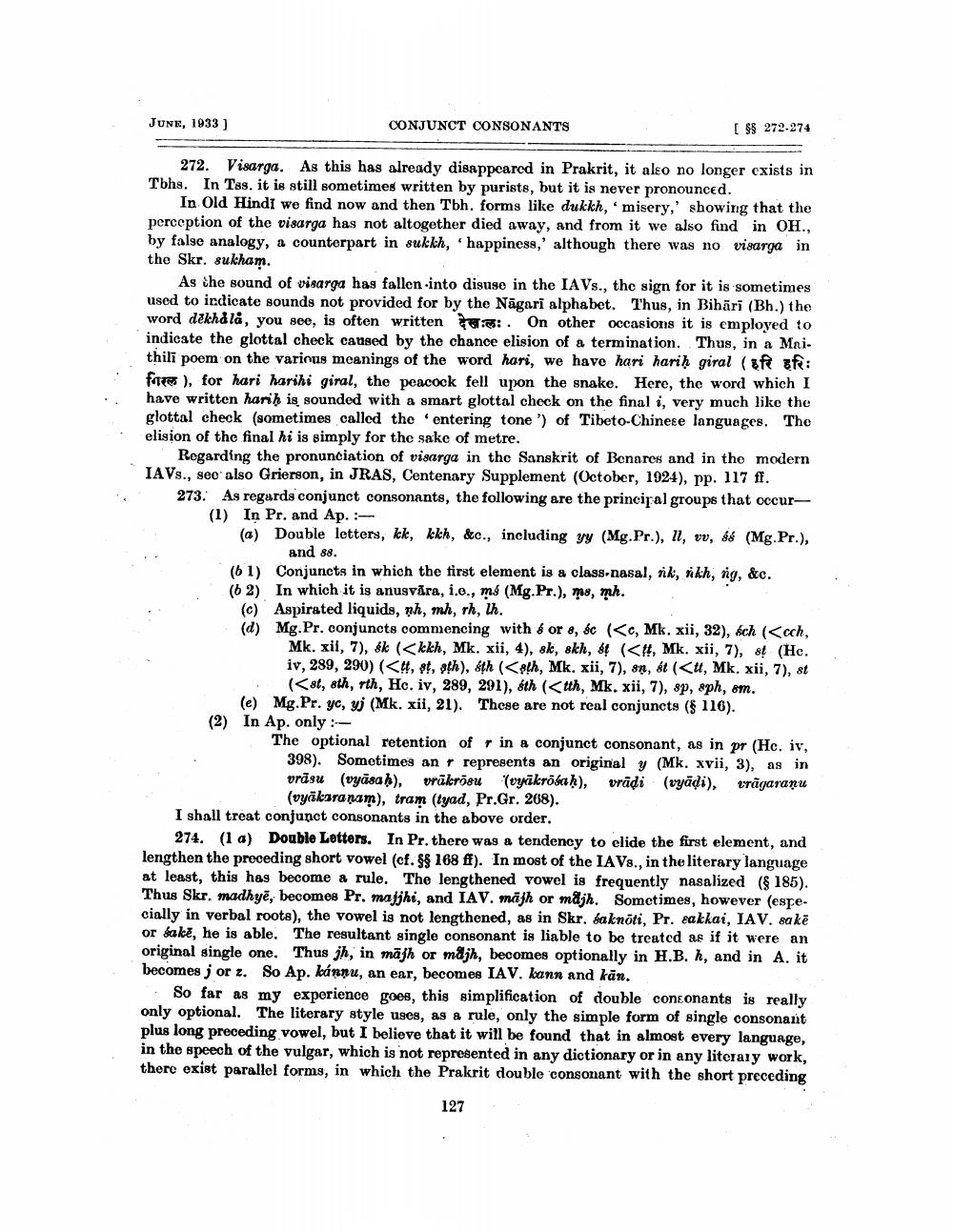________________
JUNE, 1933)
CONJUNCT CONSONANTS
[ $8 272-274
272. Visarga. As this has already disappeared in Prakrit, it also no longer exists in Tbhs. In Tss. it is still sometimes written by purists, but it is never pronounced.
In Old Hindi we find now and then Tbh. forms like dukkh, misery,' showing that the perception of the visarga has not altogether died away, and from it we also find in OH., by false analogy, a counterpart in sukkh, happiness,' although there was no visarga in the Skr. sukham.
As the sound of visarga has fallen into disuse in the IAVs., the sign for it is sometimes used to indicate sounds not provided for by the Nāgari alphabet. Thus, in Bihāri (Bh.) the word dakhdlá, you see, is often written 05:. On other occasions it is employed to indicate the glottal check caused by the chance elision of a termination. Thus, in a Mai. thili poem on the various meanings of the word hari, we have hari hariḥ giral (of af: fames ), for hari harihi giral, the peacock fell upon the snake. Here, the word which I have written harik is sounded with a smart glottal check on the final i, very much like the glottal check (sometimes called the entering tone') of Tibeto-Chinese languages. The elision of the final hi is simply for the sake of metre.
Regarding the pronunciation of visarga in the Sanskrit of Benares and in the modern IAVs., seo also Grierson, in JRAS, Centenary Supplement (October, 1924), pp. 117 ff. 273. As regards conjunct consonants, the following are the principal groups that occur(1) In Pr. and Ap. :(a) Double letters, kk, kkh, &c., including yy (Mg. Pr.), II, vv, & (Mg. Pr.),
and 88. (61) Conjuncts in which the first element is a class-nasal, rik, kh, ng, &c. (62) In which it is anusvåra, i.e., m (Mg.Pr.), ms, mh.
(c) Aspirated liquids, nh, mh, rh, lh. (d) Mg.Pr. conjuncts commencing with & or 8, 6c (<c, Mk. xii, 32), éch (<ech,
Mk. xii, 7), &k <kkh, Mk. xii, 4), sk, skh, 6t (<H, Mk. xii, 7), 8t (He. iv, 289, 290) (<#, #, oth), 6th (<8th, Mk. xii, 7), on, &t (<u, Mk. xii, 7), st
(<8t, sth, rth, Ho. iv, 289, 291), 6th (<tth, Mk. xii, 7), 8p, sph, om. (e) Mg.Pr. yc, yi (Mk. xii, 21). These are not real conjuncts ($ 116). (2) In Ap. only :
The optional retention of in a conjunct consonant, as in pr (Hc. iv,
398). Sometimes anr represents an original y (Mk. xvii, 3), as in vrasu (vyāsah), vrükrāsu (vyikrosaḥ), vrādi (vyādi), trāgaranu
(vyākaranam), tram (tyad, Pr. Gr. 208). I shall treat conjunct consonants in the above order.
274. (1 a) Double Letters. In Pr. there was a tendency to elide the first element, and lengthen the preceding short vowel (cf. &$ 168 ff). In most of the IAVs., in the literary language at least, this has become & rule. The lengthened vowel is frequently nasalized (185). Thus Skr, madhyē, becomes Pr. majjhi, and IAV. májh or majh. Sometimes, however (espe. cially in verbal roots), the vowel is not lengthened, as in Skr. Saknöti, Pr. eakkai, IAV. sakė or fake, he is able. The resultant single consonant is liable to be treated as if it were an original single one. Thus jh, in mājh or majh, becomes optionally in H.B. h, and in A. it becomes j orz. So Ap. kannu, an ear, becomes IAV. kann and kän.
- So far as my experience goes, this simplification of double consonants is really only optional. The literary style uses, as a rule, only the simple form of single consonant plus long preceding vowel, but I believe that it will be found that in almost every language, in the speech of the vulgar, which is not represented in any dictionary or in any literary work, there exist parallel forms, in which the Prakrit double consonant with the short preceding
127




